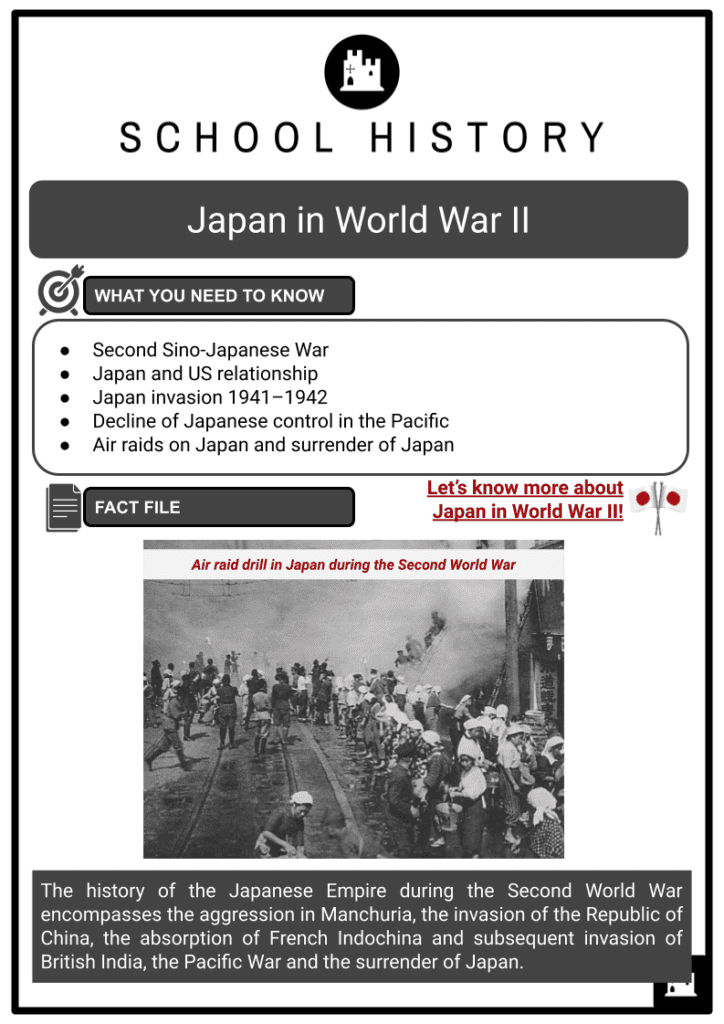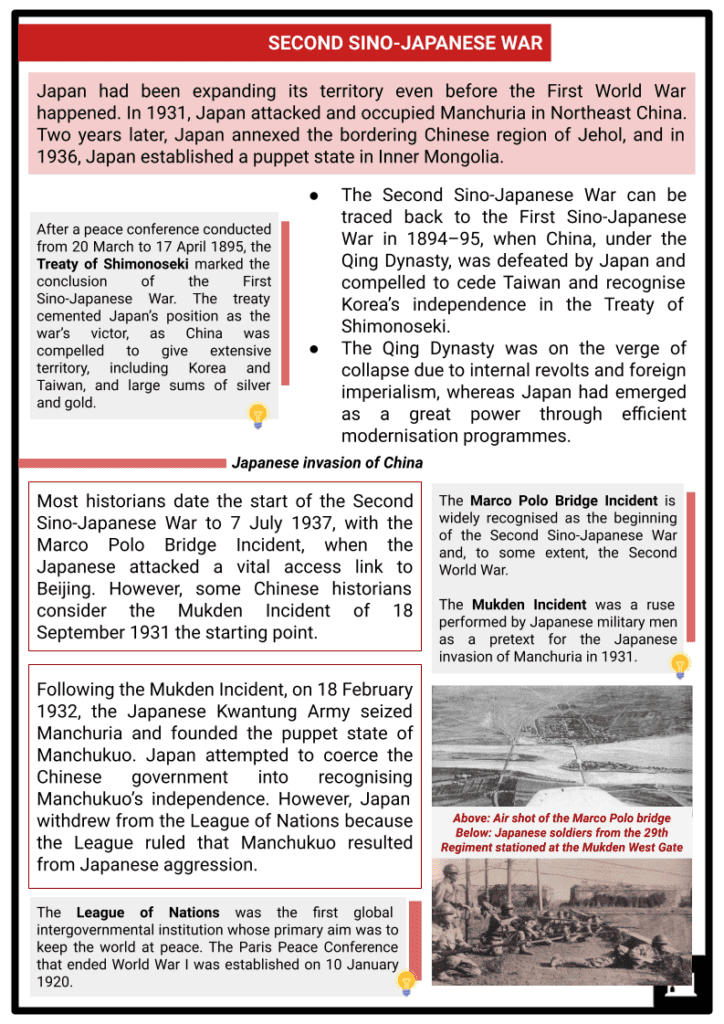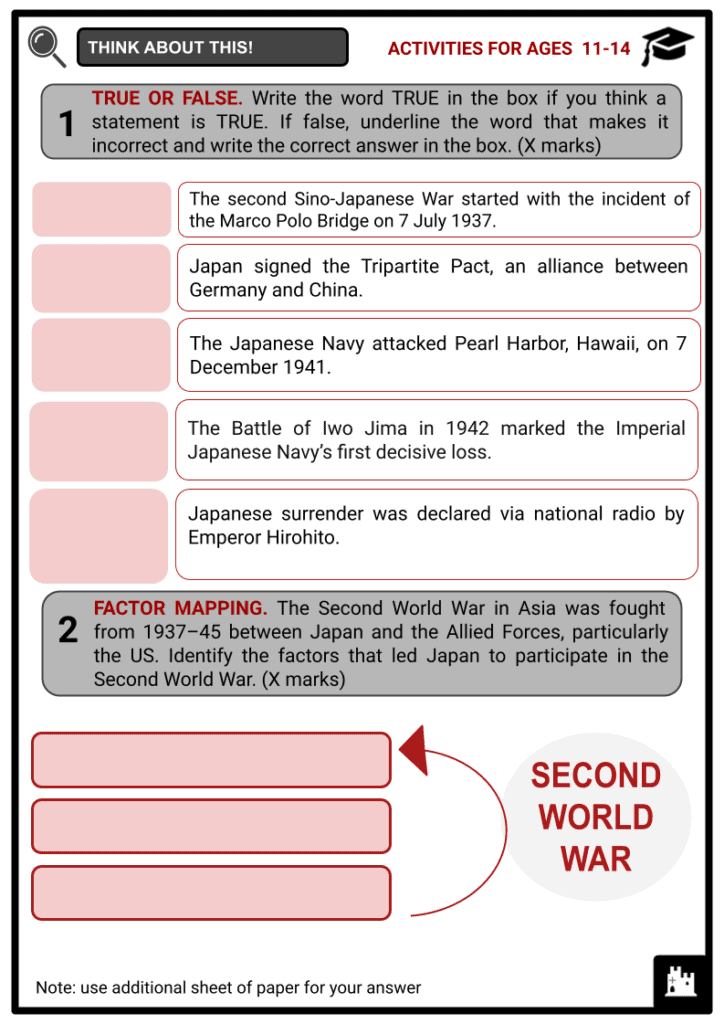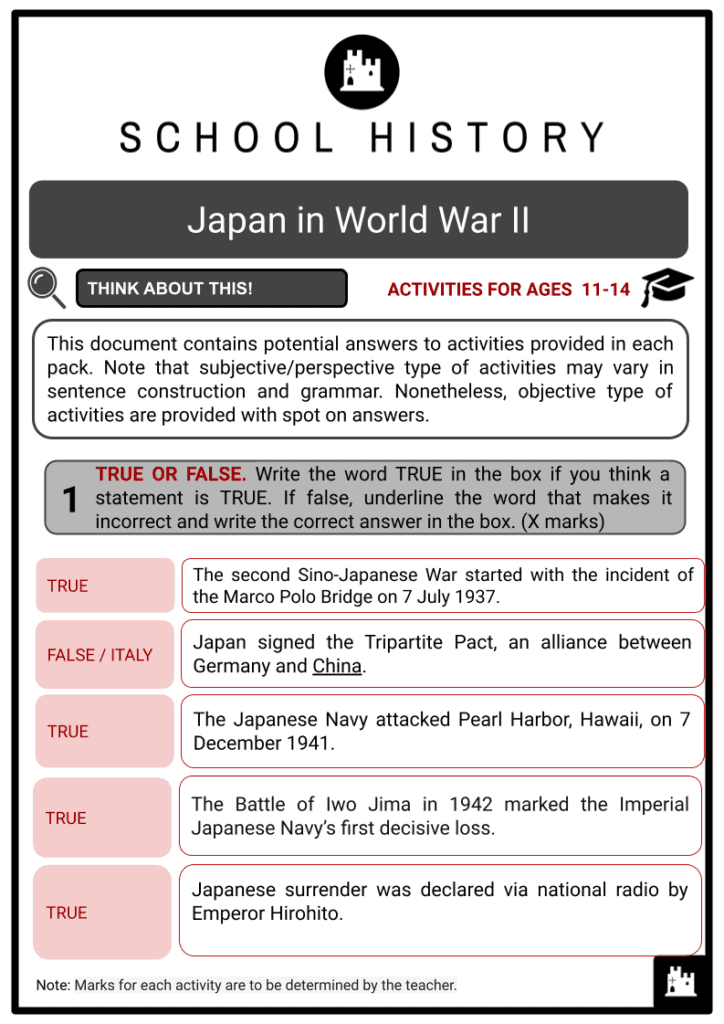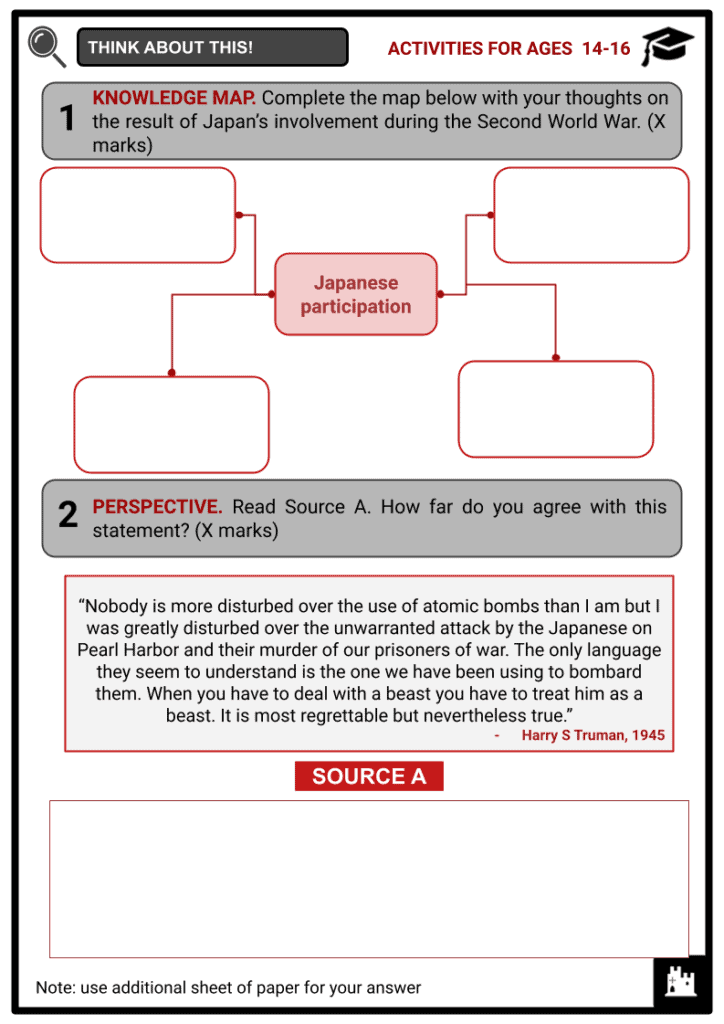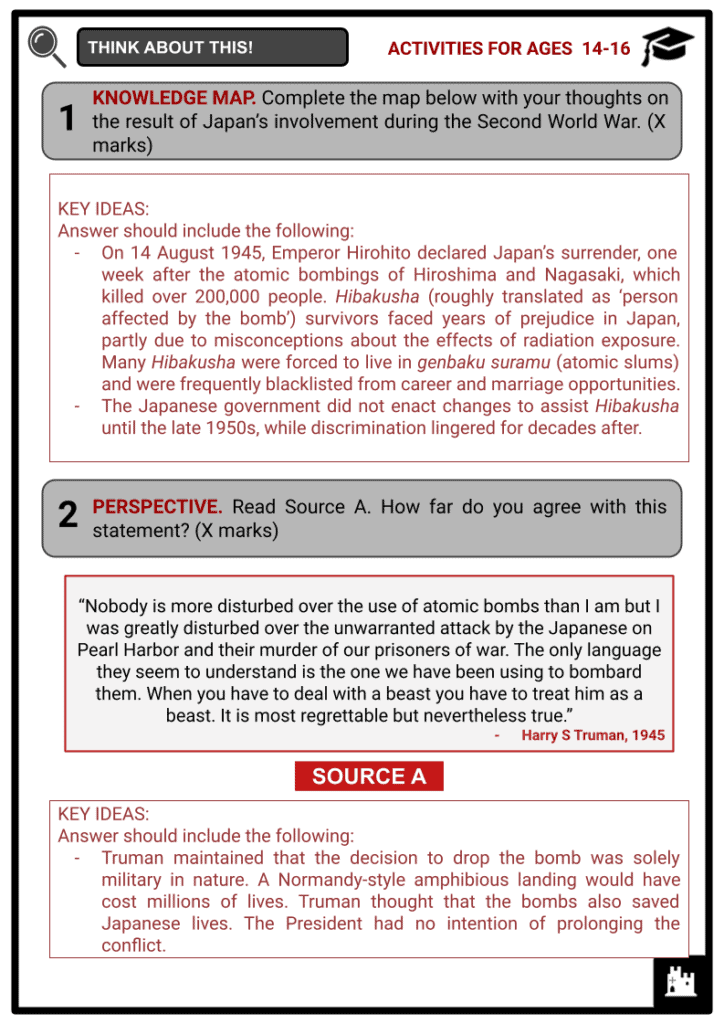Japan in World War II Worksheets
Do you want to save dozens of hours in time? Get your evenings and weekends back? Be able to teach about Japan in World War II to your students?
Our worksheet bundle includes a fact file and printable worksheets and student activities. Perfect for both the classroom and homeschooling!
Summary
- Second Sino-Japanese War
- Japan and US relationship
- Japan invasion 1941–1942
- Decline of Japanese control in the Pacific
- Air raids on Japan and surrender of Japan
Key Facts And Information
Let’s know more about Japan in World War II!
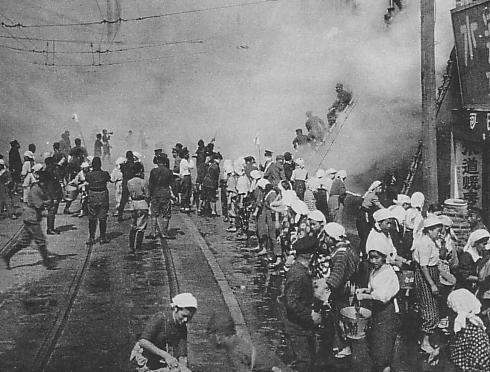
The history of the Japanese Empire during the Second World War encompasses the aggression in Manchuria, the invasion of the Republic of China, the absorption of French Indochina and subsequent invasion of British India, the Pacific War and the surrender of Japan.
SECOND SINO-JAPANESE WAR
- Japan had been expanding its territory even before the First World War happened. In 1931, Japan attacked and occupied Manchuria in Northeast China. Two years later, Japan annexed the bordering Chinese region of Jehol, and in 1936, Japan established a puppet state in Inner Mongolia.
- After a peace conference conducted from 20 March to 17 April 1895, the Treaty of Shimonoseki marked the conclusion of the First Sino-Japanese War. The treaty cemented Japan’s position as the war’s victor, as China was compelled to give extensive territory, including Korea and Taiwan, and large sums of silver and gold.
- The Second Sino-Japanese War can be traced back to the First Sino-Japanese War in 1894–95, when China, under the Qing Dynasty, was defeated by Japan and compelled to cede Taiwan and recognise Korea’s independence in the Treaty of Shimonoseki.
- The Qing Dynasty was on the verge of collapse due to internal revolts and foreign imperialism, whereas Japan had emerged as a great power through efficient modernisation programmes.
Japanese invasion of China
- Most historians date the start of the Second Sino-Japanese War to 7 July 1937, with the Marco Polo Bridge Incident, when the Japanese attacked a vital access link to Beijing. However, some Chinese historians consider the Mukden Incident of 18 September 1931 the starting point.
- The Marco Polo Bridge Incident is widely recognised as the beginning of the Second Sino-Japanese War and, to some extent, the Second World War. The Mukden Incident was a ruse performed by Japanese military men as a pretext for the Japanese invasion of Manchuria in 1931.
- Following the Mukden Incident, on 18 February 1932, the Japanese Kwantung Army seized Manchuria and founded the puppet state of Manchukuo. Japan attempted to coerce the Chinese government into recognising Manchukuo’s independence. However, Japan withdrew from the League of Nations because the League ruled that Manchukuo resulted from Japanese aggression.
- The League of Nations was the first global intergovernmental institution whose primary aim was to keep the world at peace. The Paris Peace Conference that ended World War I was established on 10 January 1920.
- After the Marco Polo Bridge Incident in July 1937, the Japanese invaded Shanghai, Nanjing and Southern Shanxi in campaigns involving around 350,000 Japanese forces and many more Chinese soldiers.
- Historians believe that up to 300,000 people died in the Nanjing Massacre following the fall of Nanjing on 13 December 1937, while other Japanese historians disputed the occurrence of a massacre. The Japanese army’s greatest progress resulted in capturing the city of Wuhan.
- The Nanjing Massacre, also known as the Rape of Nanjing, was the Imperial Japanese Army’s mass slaughter of Chinese people in Nanjing, the capital of the Republic of China, immediately following the Battle of Nanking in the Second Sino-Japanese War.
- In August 1937, aerial warfare between the Imperial Japanese Army, Chinese Air Force and Navy Air Forces began earnestly. The Chinese Air Force was effectively wiped out by the end of 1940 because China lacked the industrial, technological and military infrastructure to replace aircraft lost in action. Over the next few years, the Imperial Air Force of the Navy and the Army conducted the world’s first enormous air bombing operations on civilian targets in practically every major city in China, killing, injuring and displacing millions.
- The Battle of Shanghai was the first of 22 major engagements fought at the start of the Second Sino-Japanese War between the National Revolutionary Army of the Republic of China and the Imperial Japanese Army.
- China, unlike Japan, was unprepared for total war and needed military-industrial might, mechanised divisions and armoured forces. China had hoped that the League of Nations would provide countermeasures to Japan’s aggression until the mid-1930s. Even under these exceedingly unfavourable conditions, Chinese leader Chiang Kai Shek recognised that to gain the backing of the United States (US) or other foreign nations, China needed to demonstrate that it was capable of fighting. Because a quick retreat would discourage foreign funding, Chiang resolved to fight in the Battle of Shanghai.
Foreign Involvement
- The Second Sino-Japanese War was not merely a conflict between Japan and China. It also featured numerous other nations, each with their interests that shaped their position and actions throughout the war.
- China faced a difficult task in striving to gain the support of Allies with motivations that did not always coincide with China’s.
- Many foreign countries hesitated to lend help to China at the onset of full-scale war because they believed the Chinese would inevitably lose the war, and they did not want to antagonise the Japanese, who might, in turn, target their colonial assets in the region. They feared that any support offered to the Kuomintang would aggravate their relationship with the Japanese, who threatened the Kuomintang with a takeover within three months.
- The Kuomintang, also known as the Guomindang, the Nationalist Party of China, or the Chinese Nationalist Party, is a major political party in the Republic of China, established in Taiwan in 1949 after being based on the Chinese mainland.
- However, before the Second World War’s Asia-Pacific theatre, Germany and China enjoyed strong economic and military ties. Germany supported China in modernising its economy and military in exchange for raw materials. The Soviet leadership signed the Sino-Soviet Non-Aggression Pact in September 1937, began assisting China and authorised Operation Zet, a Soviet volunteer aviation force.
- From 1922 until 1991, the Soviet Union, officially the Union of Soviet Socialist Republics (USSR), was a transcontinental country encompassing much of Eurasia.
- As part of the covert effort, Soviet specialists upgraded and managed some of China’s military transport. Before the arrival of Western allies, the Soviet Union supplied the most foreign help to China, totalling over $250 million in credits for munitions and supplies. As a result of the Soviet-Japanese Neutrality Pact and the start of the Great Patriotic War in 1941, Soviet help halted. This agreement prevented the Soviet Union from fighting both Germany and Japan simultaneously.
- The Great Patriotic War is a term used in Russia and certain other former Soviet republics to describe the battle waged from 22 June 1941 to 9 May 1945 along the multiple fronts of the Second World War’s Eastern Front, chiefly between the Soviet Union and Nazi Germany.
- Events such as the Japanese attack on the USS Panay and the Nanking Massacre swung public opinion in the West sharply against Japan. They increased their fear of Japanese expansionism in December 1937, prompting the US, the United Kingdom (UK) and France to lend money to the Kuomintang for war supply contracts.
- Furthermore, in 1938, Australia prohibited a Japanese government-owned corporation from acquiring an iron mine in Australia and barred iron ore exports. Japan replied by invading Vietnam in 1940, successfully blockading China and preventing the arrival of munitions, fuel, and 10,000 metric tonnes of equipment supplied by the Western Powers via the Haiphong-Yunnan Fou railway line.
- The Anti-Comintern Pact, officially the Agreement Against the Communist International, was an anti-communist deal signed on 25 November 1936 between Nazi Germany and the Empire of Japan. It was aimed at the Communist International (Comintern).
- Japan attacked French Indochina on 22 September 1940 as part of its operations against China. It signed the Tripartite Pact with Germany and Italy on 27 September 1940. The Tripartite Pact established a defence alliance between the countries, to discourage the US from entering the conflict. Before this, Germany and Japan were already in an alliance agreement in 1936 with the signing of the Anti-Comintern Pact.
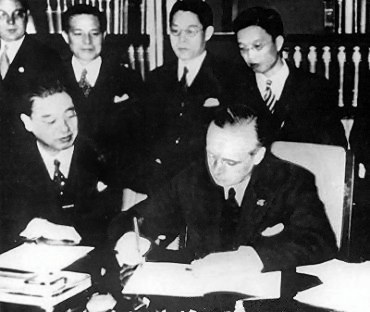
The Anti-Comintern Pact was signed by Japanese envoy Kintomo Mushanokji and German ambassador-at-large Joachim von Ribbentrop
TRIPARTITE ACT
- Japan formally joined the Axis Powers by signing the Tripartite Pact. The trilateral pact was enacted on 27 September 1940 between Germany, Italy and Japan. One year after the Second World War began, a goal was to form a defence alliance and to discourage the US from entering the war. Hungary, Romania, Slovakia, Bulgaria, Yugoslavia and Croatia later signed the pact. The Axis Powers was an alliance that opposed the Allied Powers in the Second World War. The principal Allied Powers during the Second World War were composed of the UK, France, the Soviet Union, the US and China.
- Western Allied leaders did not forget the initial non-aggression pact between Soviet Premier Joseph Stalin and Adolf Hitler in 1939. However, Germany’s invasion of the Soviet Union and Japan’s attack on Pearl Harbor resulted in a USSR–US alliance.
- China fought Japan with the help of the Soviet Union and the US. Following the Japanese attacks on Malaya and Pearl Harbor in 1941, the war amalgamated with other battles widely classified as Second World War conflicts, creating a major sector known as the China Burma India Theatre.
- Some scholars believe the European and Pacific engagements were entirely independent, albeit contemporaneous. Other scholars suggest that the outbreak of the full-scale Second Sino-Japanese War in 1937 marked the start of the Second World War.
JAPAN AND US RELATIONSHIP
- Since early 1941, the US and Japan had been negotiating to mend their strained relations and bring the war in China to an end. During these conversations, Japan presented several ideas the Americans rejected as inadequate. At the same time, the US, the UK and the Netherlands were secretly planning a joint defence of their territories in case of a Japanese attack on any of them.
- Japan readied for war, frustrated by the lack of progress and feeling the squeeze of American–British–Dutch sanctions. A new government led by Hideki Tojo offered an interim proposal as its final offer on 20 November. It demanded the cessation of American aid to China and the removal of the embargo on the delivery of oil and other resources to Japan.
- Japan vowed not to launch any hostilities in Southeast Asia and to remove its forces from southern Indochina in exchange. The American counter-proposal of 26 November demanded that Japan unconditionally leave all of China and sign non-aggression treaties with all Pacific powers.
- This effectively forced Japan to choose between abandoning its ambitions in China and seizing the natural resources it required in the Dutch East Indies by force. The Japanese military did not consider the former an option, and many officers saw the oil embargo as an unspoken declaration of war.
- Japan intended to quickly conquer European colonies in Asia to establish a wide defensive perimeter spanning the Central Pacific. To avoid American intervention while defending the perimeter, there was also a plan to neutralise the US Pacific Fleet and the US troops stationed in the Philippines.
JAPANESE INVASION 1941–1942
- On 7 December 1941, Japan launched simultaneous offensives against British and American colonies in Southeast Asia and the Central Pacific. The Imperial Japanese Army bombed American warships at Pearl Harbor, the Philippines, Guam, and Wake Island, and landings in Malaya, Thailand and Hong Kong. However, as Admiral Yamamoto predicted, the strike caused minor long-term damage to the US Navy by ignoring priority targets such as the Pacific Fleet’s three aircraft carriers at sea and vital shore installations. The Americans viewed the attack as a savage and cowardly deed and rallied against the Japanese Empire.
- The Japanese invasion of Thailand prompted Thailand to ally with Japan, and other Japanese attacks prompted the US, UK, China, Australia and several other states to formally declare war on Japan.
- At the same time, the Soviet Union, which was heavily involved in war with Germany, maintained its neutrality agreement with Japan. On the other hand, Germany declared war on the US in solidarity with Japan, claiming American strikes on German warships ordered by US President Franklin Roosevelt as the reason.
- The US launched a full-scale attack on the European and Pacific theatres. Adolf Hitler, Germany’s leader, and Benito Mussolini, Italy’s leader, declared war on the US four days later. Japan began offensives against the Allied forces in East and Southeast Asia, simultaneously attacking British Hong Kong, British Malaya, Borneo, the Dutch East Indies, Gilbert Islands, Thailand and the Philippines.
- By 1942, the Japanese Empire had launched offensives in the Dutch East Indies, New Guinea, Singapore, Burma, Yunnan, India, the Solomons, Timor, the Aleutian Islands, Andaman Islands, Christmas Island and the Solomon Sea. When the Second World War was in full swing, Japan was considered the most interested in using biological weapons. The Japanese Air Force dropped many ceramic bombs with bubonic plague-infested fleas in Ningbo, China.
INVASION OF SOUTHEAST ASIA
- The Japanese Empire conducted years of propaganda and espionage in the region before the Southeast Asian campaign. Japan proclaimed their vision of a Greater Asian Co-Prosperity Sphere and an Asia for Asians to the people of Southeast Asia, who had lived under European control for years. As a result, many residents in several colonies (especially Indonesia) sided with the Japanese invaders for anti-colonial reasons.
- Greater East Asia Co-Prosperity Sphere is an economic and political alliance of Asian states that the Japanese Empire sought to create across Asia. It is an economic and military bloc comprising East and Southeast Asian states opposing Western colonialism and manipulation.
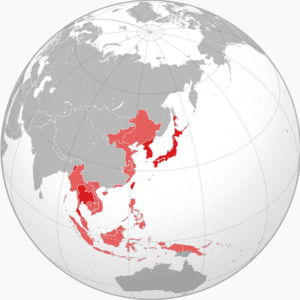
Map showing the members of the Greater East Asia Co-Prosperity Sphere (in red) - On 25 December 1941, Hong Kong surrendered to the Japanese. The Japanese defeated an Allied army of British, Indian, Australian and Malay forces in Malaya. The Japanese advanced rapidly down the Malay Peninsula, forcing the Allied soldiers to retreat into Singapore. The Allies lacked air cover and tanks, while the Japanese dominated the skies.
- By the end of January 1942, the final Allied forces had crossed the Johor Strait and entered Singapore. The Japanese pushed the joint Filipino-American army towards the Bataan Peninsula and, later, the island of Corregidor in the Philippines. Manuel L Quezon, the Philippine President at that time, and US General of the Army General Douglas MacArthur were forced to escape in the face of Japanese advances by January 1942.
- This was one of the biggest setbacks experienced by the Americans, with over 70,000 American and Filipino prisoners of war in Japanese hands.
- Due to the overwhelming superiority of Japanese forces and encirclement tactics, Singapore fell to the Japanese on 15 February 1942, resulting in the greatest surrender of British-led military soldiers in history. An estimated 80,000 Indian, Australian and British troops were captured as prisoners of war, adding to the 50,000 captured during the Japanese invasion of Malaya (modern-day Malaysia).
- Many were eventually exploited as forced labourers to build the Burma Railway. After they invaded British Malaya, the Japanese troops immediately defeated the Chinese people in Malaya and Singapore.
- The Japanese defeated the Dutch soldiers and took the late Dutch East Indies’ critical oil production zones of Borneo, Central Java, Cepu, Malang, Sumatra and Dutch New Guinea. However, Allied sabotage made it difficult for the Japanese to return to pre-war oil output levels. The Japanese strengthened their supply routes by taking crucial Pacific islands like Guadalcanal.
BATTLE OF MIDWAY
- The Battle of Midway was a decisive Allied naval victory and a significant turning point in the Second World War. From 4–7 June 1942, Japanese and American carrier forces engaged around the Midway Atoll, a US territory in the central Pacific.
- The combined Japanese fleet intended to attack the atoll and draw the smaller US Pacific Fleet into a decisive fight. The Japanese anticipated that destroying the US fleet just six months after they attacked Pearl Harbor would be the final nail in the coffin for the Americans, leading them to sue for a negotiated peace with Japan.
- Admiral Chester Nimitz, head of the US Pacific Fleet, had been notified of Japanese intentions via Ultra, the Allied code-breaking network. Nimitz deployed two carrier groups to ambush the Japanese, relying on Ultra decrypts. The Japanese only became aware of the presence of American carriers off the coast of Midway once it was too late. After spotting them via a break in the clouds, American dive bombers wreaked havoc on the Japanese navy. On the morning of 4 June 1942, American aircraft crippled three Japanese carriers in less than five minutes.
- In the mid-afternoon, a fourth Japanese carrier was destroyed. The Japanese combined navy lost four modern carriers, 248 carrier aircraft, and approximately 3,000 sailors and aircrews in a single day. The Americans lost one carrier, the USS Yorktown, which sank on 7 June. A decisive American victory dealt a devastating blow to Japanese naval power.
- The Pacific now had naval parity, but the Japanese would never recover from their losses at Midway. The Japanese navy would maintain six carriers from 1942 to 1944. During the same period, the US Navy launched 14 carriers, 9 light carriers and 66 escort carriers, demonstrating the might of American industrial power. The Japanese were now on the defensive in the Pacific, and the Allies had the initiative.
DECLINE OF JAPANESE CONTROL IN THE PACIFIC
- The US had multiple interests in the western Pacific to safeguard, including access to the Chinese market and its colonies – the Philippines and Guam, won during the Spanish-American War in 1898. Following Japan’s triumphs in the Sino-Japanese War and the Russo-Japanese War, the US began to see Japan as a potential danger to its western Pacific interests.
- This hostility was heightened by Japan’s opposition to a proposal to annex Hawaii to the United States, as well as Japan’s opposition to discrimination against Japanese immigrants in both Hawaii and California. As a result, the US Navy began drafting war plans against Japan as early as 1897, later designated as the War Plan Orange. The 1911 war plan, drafted by Rear Admiral Raymond P Rodgers, envisioned an island-hopping tactic for invading Japan.
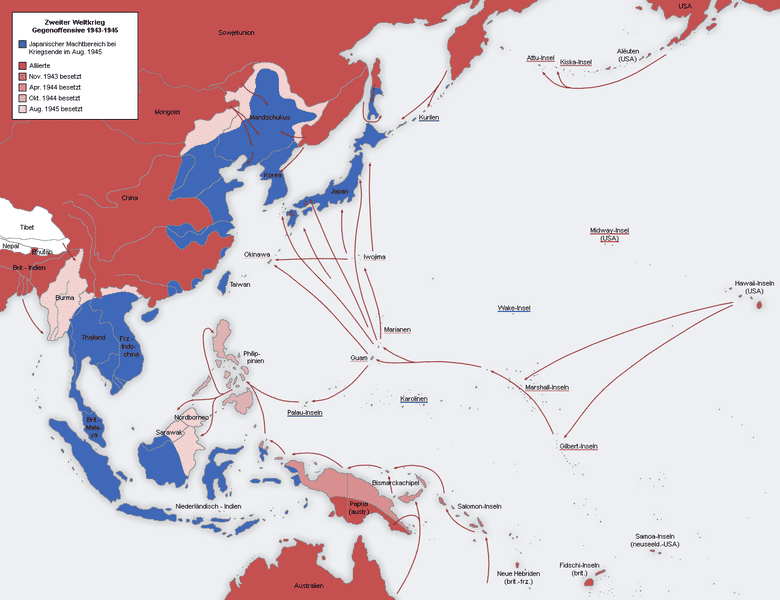
Allied island-hopping campaign 1943–1945: Blue – Japanese-held territory Aug. 1945; Dark red – Allied territory; Red – Occupied Nov. 1943; Dark pink – Occupied Apr. 1944; Pink – Occupied Oct. 1944; Light pink – Occupied Aug. 1945 - The Allies employed the leapfrogging tactic, also known as island hopping, partly because they used submarine and air operations to blockade and isolate Japanese bases, weakening their garrisons and diminishing the Japanese ability to resupply and reinforce them.
- As a result, troops on islands that had been bypassed, such as the principal base at Rabaul, were rendered ineffective to the Japanese war effort and were allowed to ‘wither on the vine’.
- MacArthur strongly backed this policy in his endeavour to liberate the Philippines from Japanese rule. In late 1943, Operation Cartwheel began to apply this concept. Operation Cartwheel was a key military operation for the Allies in the Second World War’s Pacific theatre.
- MacArthur’s Operations Cartwheel, Reckless and Persecution were the first successful Allied leapfrogging operations. They landed on lightly held beaches with minimum fatalities while cutting off Japanese soldiers hundreds of kilometres from their supply sources.
- MacArthur described his version of leapfrogging as distinct from the style favoured by Admiral Chester Nimitz’s Central Pacific Area, which favoured direct assaults on heavily defended beaches and islands, resulting in massive casualties for such small parcels of land as Tarawa, Peleliu, Saipan, Guam, Iwo Jima and Okinawa.
- Leapfrogging would allow US forces to reach Japan swiftly while avoiding the time, personnel and supplies required to seize every Japanese-held island. It would give the Allies the benefit of surprise and throw the Japanese off guard. There would be two prongs to the overall leapfrogging plan. A force led by Nimitz would push north towards the island, capturing the Gilbert and Marshall Islands and the Marianas, usually towards the Bonin Islands. The southern prong, led by MacArthur and equipped with greater land forces, would seize the Solomons, New Guinea and the Bismarck Archipelago before moving on to the Philippines.
AIR RAIDS ON JAPAN AND SURRENDER OF JAPAN
- From 1942 until 1945, Allied troops conducted air strikes on Japan, causing considerable damage to the country’s cities and killing between 241,000 and 900,000 people. These attacks were restricted to the Doolittle Raid in April 1942 and small-scale strikes on military sites in the Kuril Islands beginning in mid-1943. Strategic bombing raids began in June 1944 and lasted until August 1945, when the war ended. Allied naval and land-based tactical air forces assaulted Japan in 1945 as well.
- The US Army Air Forces campaign against Japan began in earnest in mid-1944 and accelerated in the last months of the war. While plans for strikes on Japan were made before the Pacific War, they could only be carried out once the long-range Boeing B-29 Superfortress bomber was ready for action.
- From June 1944 to January 1945, B-29s based in India organised nine raids on targets in western Japan via bases in China, but the mission was futile. The strategic bombing campaign was greatly expanded when ports in the Mariana Islands became accessible due to the Mariana Islands Campaign in November 1944.
- During 1945, planes flying from Allied aircraft carriers and the Ryukyu Islands often hit targets in Japan in preparation for the anticipated invasion of Japan in October 1945. Hiroshima and Nagasaki were bombed and mostly destroyed by atomic bombs in early August 1945.
- One of the major elements influencing the Japanese government’s decision to surrender in mid-August 1945 was the Allied bombing campaign. However, there has long been a dispute about the morality of the strikes on Japanese cities, and the deployment of atomic weapons is especially contentious.
- The most widely quoted figure for Japanese casualties from the raids is 333,000 killed and 473,000 wounded. Other estimates range from 241,000 to 900,000 deaths. In addition to the loss of primarily civilian lives, the raids significantly dropped industrial production.
JAPANESE SURRENDER
- Emperor Hirohito announced the surrender of the Empire of Japan in the Second World War on 15 August 1945, and it was subsequently signed on 2 September 1945, putting the war’s hostilities to an end. The Imperial Japanese Navy (IJN) had become incapable of conducting major operations by the end of July 1945, and an Allied invasion of Japan was near.
- The US, the UK and China called for the unconditional surrender of the Japanese military forces in the Potsdam Declaration on 26 July 1945. While officially declaring their intention to fight, Japan’s leaders privately pleaded with the publicly neutral Soviet Union to arrange a peace settlement on terms more advantageous to the Japanese government.
- While maintaining a sufficient level of diplomatic engagement with the Japanese to give the impression that they might be willing to mediate, the Soviets were secretly preparing to attack Japanese forces in Manchuria and Korea in fulfilment of promises made secretly to the US and the UK at the Tehran and Yalta Conferences. The Soviet Union declared war on Japan late in the evening of 8 August 1945, in compliance with the Yalta agreements but in violation of the Soviet-Japanese Neutrality Pact, and just after midnight on 9 August 1945, the Soviet Union invaded the Imperial Japanese puppet state of Manchukuo.
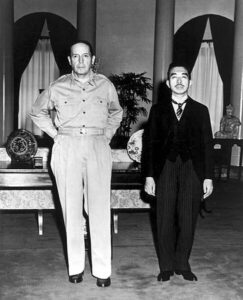
MacArthur (left) and Hirohito (right) - Hours later, the US unleashed a second atomic bomb on Nagasaki, Japan. Following this, Emperor Hirohito intervened and directed the Supreme Council for the Direction of the War to accept the Potsdam Declaration’s terms for ending the war.
- After several days of behind-the-scenes discussions and a failed coup, Emperor Hirohito issued a recorded radio speech across the Empire on 15 August 1945 declaring Japan’s surrender to the Allies.
- The occupation of Japan, directed by the Supreme Commander for the Allied Powers, commenced on 28 August. The surrender ceremony took place aboard the USS Missouri on 2 September 1945, when delegates from the Japanese government signed the Japanese Instrument of Surrender, concluding the war.
- V-J Day, the war’s end, was celebrated by the Allied public and military troops. However, isolated soldiers and personnel from Japan’s far-flung forces throughout Asia and the Pacific refused to surrender for months and years afterwards, some even refusing until the 1970s.
Image Sources
- https://commons.wikimedia.org/wiki/File:Air_Raid_Drill_in_Japan_during_World_War_II1.JPG
- https://en.wikipedia.org/wiki/File:Anti-Comintern_Pact_signing_1936.jpg
- https://en.wikipedia.org/wiki/File:Greater_Asian_Co-prosperity_sphere.png
- https://en.wikipedia.org/wiki/File:Second_world_war_asia_1943-1945_map_de.png
- https://en.wikipedia.org/wiki/File:Macarthur_hirohito.jpg
Frequently Asked Questions
- What was Japan's role in World War II?
Japan was one of the Axis Powers in World War II. It aimed to expand its empire in Asia and the Pacific through military conquest and alliances with Germany and Italy.
- What were the main reasons for Japan's involvement in WWII?
Japan sought to secure resources like oil, rubber, and minerals by expanding its territorial control in Southeast Asia. Additionally, it aimed to establish a Greater East Asia Co-Prosperity Sphere under Japanese dominance.
- When did Japan enter World War II?
Japan entered the war on 7 December 1941, when it launched a surprise attack on the U.S. Pacific Fleet at Pearl Harbor, Hawaii.

